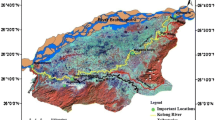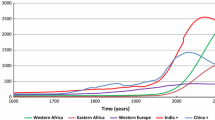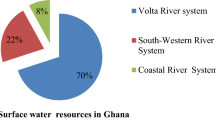Abstract
Vulnerability of water resources to degradation is one of the critical issues facing developing countries. Changes in population and land use associated with urbanization may alter social interdependence of water bodies in the vicinity of urban and periurban areas thereby affecting their sustainability. Preservation and proper management of lakes are urgently needed to ensure that these freshwater ecosystems continue to deliver their services to the people in the changing scenarios resulting from urbanization. In this paper, we make use of indicators, a powerful tool in decision making, and propose Water Bodies Protection Index (WBPI), which can serve as monitoring cum ranking tool to prioritize conservation efforts for periurban water bodies. Water quality, biological diversity, encroachment of the lakes, role played by the local community in lake management and preservation, and implementation of existing Acts for protection of water resources by government agencies are the five factors chosen for formulating this index. The data and information for this were obtained through socio-ecological study of six water bodies situated in the urban to rural gradient at the southern fringe of Chennai city in south India. Weightages were assigned to the above factors based on a Delphi study. A simple aggregation of weighted factors yields the index that classifies the protection status from poor (<2.5) to sustainable (>9). Application of the WBPI to the study lakes and comparing it with an urbanization index from the literature for the locations of the study lakes provided satisfactory classification and correlation, respectively. The WBPI is expected to help assess many such water bodies elsewhere to set targets for their revival and preservation.



Similar content being viewed by others
References
Ariza, P., Galan, E., Serrano, T., & Reyes-Garcia, V. (2007). Water tanks as ecosystem, local ecosystemic perception for integral management of water tanks in Tamil Nadu, South India. Revista de recerca I formacio on antropologia, 7, 1–27.
Arul, C. (2008). Gaps in irrigation laws of Tamil Nadu. A doctoral thesis, Faculty of Civil engineering, Anna University, p. 285.
Avramoski, O. (2004). The role of public participation and citizen involvement in Lake Basin management. Thematic Paper, Lake Basin Management Initiative, Thematic Paper, 16. http://www.worldlakes.org.
Costanza, R., Norton, B. G., & Haskell, B. D. (1992). Toward an operational definition of ecosystem health. In R. Costanza, B. G. Norton, & B. D. Haskell (Eds.), Ecosystem health: New goals for environmental management (pp. 239–256). Washington DC: Island Press.
Cude, C. G. (2001). Oregon Water Quality Index: A tool for evaluating water quality management effectiveness. Journal of the American Water Resources Association, 37(1), 125–137.
Dahl, A. L. (2012). Achievements and gaps in indicators for sustainability. Ecological Indicators, 17, 14–19.
Datta, P. (2006). Urbanization in India, regional and sub regional dynamic population process in urban areas. European population conference, Kolkata.
DeFries, R., & Eshleman, K. N. (2004). Land-use change and hydrologic processes: A major focus for the future. Hydrological Processes, 18(11), 2183–2186.
Dhan (Ed.). (2002). Village tanks of South Asia. In Papers and proceedings of the regional workshop, Madurai, India. Research and Documentation Resource Centre, Dhan Foundation, Madurai, 625101, India.
Fathi, A. A., Abdelzaher, H. M. A., Flower, R. J., Ramdani, M., & Kraïem, M. M. (2001). Phytoplankton communities of North African wetland lakes: The CASSARINA project. Aquatic Ecology, 35(3–4), 303–318.
Ferng, J. J. (2007). Human freshwater demand for economic activity and ecosystems in Taiwan. Environmental Management, 40(6), 913–925.
Habib, M. A. B., Yusoff, F. M., Phang, S. M., Ang, K. J., & Mohamed, S. (1997). Nutritional values of chironomid larvae grown in palm oil mill effluent and algal culture. Aquaculture, 158(1–2), 95–105.
Hosmani, S. P., Vasanthakumar, L., & Partha, S. (1999). Ecological significance of biochemical parameters in certain fresh water lakes of Mysore. Journal of Environmental Biology, 20(2), 121–124.
Jafari, N. G., & Gunale, V. R. (2006). Hydrobiological study of algae of an urban freshwater river. Journal of Applied Science and Environmental Management, 10(2), 153–158.
Lee, Y. J., & Huang, C. M. (2007). Sustainability index for Taipei. Environmental Impact Assessment Review, 27(6), 505–521.
McCormick, V. P., & Cairns, J. (1994). Algae as indicators of environmental change. Journal of Applied Phycology, 6, 509–526.
Mitsch, W. J., & Gosselink, J. G. (2000). Wetlands (4th ed.). New York: Wiley.
Mwanza, D. D. (2005). Water for sustainable development in Africa. In L. Hens & B. Nath (Eds.), The world summit on sustainable development: The Johannesburg conference (pp. 91–111). The Netherlands: Springer.
Ouyang, Y. (2005). Evaluation of water quality monitoring stations by principal component analysis. Water Research, 39(12), 2621–2635.
Palmer, C. M. (1969). A composite rating of algae tolerating organic pollution. Journal of Phycology, 15(1), 78–82.
Person, J. L. (1989). Environmental science investigations. New York: J. M. LeBel Enterprises, Ltd.
Pichyakorn, B. (2002). Sustainable development and international watercourse agreements: The Mekong and the Rhine. International Union for the Conservation of Nature (Draft 30 June 2002).
Pinilla, G. (2010). An index of limnological conditions for urban wetlands of Bogota city, Colombia. Ecological Indicators, 10(4), 848–856.
Ratnavel, S. M., & Gomathinayagam, P. (2006). In search of ancient wisdom—Irrigation tanks (1st ed.). Madurai, India: Dhan Foundation.
Schoonover, J. E., Lockaby, B. G., & Pan, S. (2005). Changes in chemical and physical properties of stream water across an urban-rural gradient in western Georgia. Urban Ecosystems, 8(1), 107–124.
Sethukkarasi, S. (2008). An index for measuring urbanization in Tambaramtaluk, south of Chennai city. Master thesis (IWRM), Centre for Water Resources, Anna University, Chennai.
Silva, T., Vinçon-Leite, B., Tassin, B., Petrucci, G., Seidl, M., Lemaire, B., et al. (2011). An integrated approach for urban water modelling, linking a watershed hydrological model and a cyanobacteria dynamics model in urban lakes. 12th international conference on urban drainage, Porto Alegre/Brazil, 11–16.
Singg, R. N., & Webb, B. R. (1979). Use of Delphi methodology to assess goals and social impact of a watershed project. Journal of the American Water Resources Association, 15(1), 136–143.
Stambuk-Giljanovic, N. (1999). Water quality evaluation by index in Dalmatia. Water Research, 33(16), 3423–3440.
Sullivan, C. A., & Meigh, J. R. (2006). Application of the water poverty index at different scales: A cautionary tale. Water International, 31(3), 412–416.
Trivedy, R. K. (1986). Role of algae in biomonitors in river ecology. Symposium on biomonitoring state environment, pp. 183–189.
Author information
Authors and Affiliations
Corresponding author
Rights and permissions
About this article
Cite this article
Sudha, M.C., Ravichandran, S. & Sakthivadivel, R. Water Bodies Protection Index for assessing the sustainability status of lakes under the influence of urbanization: a case study of south Chennai, India. Environ Dev Sustain 15, 1157–1171 (2013). https://doi.org/10.1007/s10668-012-9431-z
Received:
Accepted:
Published:
Issue Date:
DOI: https://doi.org/10.1007/s10668-012-9431-z




